The Historical greatness of Saba
The Saba island has been around for many centuries. It was created above the area of a dormant volcano. The Island was home to the Ciboney tribes during the late 1300's and early 1400's. In 1493 Christoper Columbus discovered the island but Europeans were not fully welcomed until 1640. During that time period before the discovery many settlers pushed most of the Ciboney tribe away from the area. Creating a mixture of tribes, cultures and nations. The island of Sint Eustatius sent people to the Saba island in order to colonize there. This further brought more cultural diversity to the island. Leading to many different languages, and traditions. The Island was constantly being traded from Dutch,French,Spanish,and English for two centuries. It wasn't until 1816 when the Island was sold to the Dutch and has been under Dutch control since. Due to the mixed culture there is many Dutch traditions and a accumulation of many others. The culture consist of African Latin and European decedents. There have been three colonies to have settled there and four different nations to have once owned it. The islands history is reflected through its people by the numerous traditions that embrace their spirituality. They also participate in many sea activities to tribute the lifestyle of the many people that settled in the island because fishing was their main source of income. The Saba Islands have had a diversified past from being switched from culture to culture and having a mixed race population. The Island finally was able to settle and cultivate all the cultures in to one mixed ambiguous culture.




Gustavious,
ReplyDeletePresented in your blog post is a decent overview of the island, but I would like to see sources for the information, as well as the details presented fleshed out in a meaningful way. For instance, what happened when settlers came into contact with indigenous people? Are there any data to suggest the amount of indigenous people remaining on the island, or are they only recognizable as parts of modern Saba culture? There are some details and dates which would have benefited greatly from adding a primary or secondary source in the form of a hyperlink which could allow me to explore information more broadly.
I would also like to see the pictures used more accurately represent the history of the island. The two photos presented work for a broad-strokes overview, but do little to excite the reader about the unique history of this island.
Overall, this would look really good as the first section of a larger, more in depth look at your island, but as a stand alone article, it leaves much to be desired. You are on the right track, so keep striving to flesh out the details!